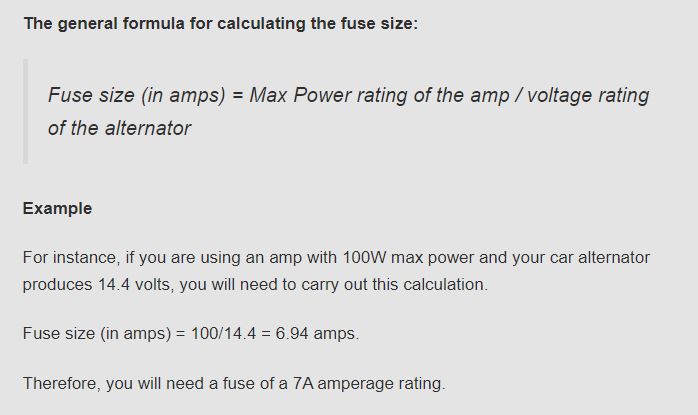How do you calculate amp fuse size?
By dividing the max power rating of your amp by the voltage reading of the alternator, you can determine the fuse size you need.
The general formula for calculating the fuse size:
Fuse size (in amps) = Max Power rating of the amp / voltage rating of the alternator
Example
For instance, if you are using an amp with 100W max power and your car alternator produces 14.4 volts, you will need to carry out this calculation.
Fuse size (in amps) = 100/14.4 = 6.94 amps.
Therefore, you will need a fuse of a 7A amperage rating.
Car amps are powerful electronic devices. By powerful we mean, they draw a good amount of current and operate at higher wattages. Like any other expensive and high current and power rating device, they are protected through a fuse. However, many car owners don’t know much about amp fuses.
Therefore, when an amp fuse blows, they don’t know what to do.
In this post, we will share with you an amp fuse size chart that will help you in doing the replacement work in case the existing fuse blows. Also, you can see our list of recommended fuse holders.
Table of Contents
Car Amp Fuse Size Chart
Before we share the chart, know how to determine which fuse has what size. For starters, a fuse is not rated for power like amplifiers. Instead, they have an amperage rating. Therefore, if you see a fuse with “50” printed on it, it indicates 50A, not 50W. This is also referred to as the size of the fuse.
Some fuses are classified further by the gauge input they are made for. This reading is usually given in AWG (American Wire Gauge) — a unit-less US-standard measure to indicate the diameter of electrical conductors (mostly wires).
The AWG rating has an inverse relation with the diameter of the electric conductor, i.e., the higher the AWG, the lower the diameter. For instance, a wire with a 12-AWG rating will be thicker (higher diameter) than a 14-AWG wire.
| Max Power Rating of Amp | Wire Gauge | Recommended Fuse Size |
| 105W | 16 AWG | 7.5 Amps |
| 210W | 14 AWG | 15 Amps |
| 240W | 12 AWG | 20 Amps |
| 420W | 10 AWG | 30 Amps |
| 700W | 8 AWG | 50 Amps |
| 1120W | 6 AWG | 80 Amps |
The above chart is compiled with the assumption that the alternator is providing a 14V voltage supply.

Now, let’s answer some frequently asked questions about amp fuse sizes.
What fuse size for a 500-watt amp?
With an alternator providing 14.4 volts, you will need a 35A fuse for your 500W amplifier.
What fuse size is needed for a 1000-watt amp?
With an alternator providing 14.4 volts, you will need a 70A fuse for your 1000W amplifier.
What fuse size is needed for a 2000-watt amp?
With an alternator providing 14.4 volts, you will need a 140A fuse for your 2000W amplifier.
What size fuse for a 3000-watt amp?
With an alternator providing 14.4 volts, you will need a 210A fuse for your 2000W amplifier.
What happens if I put a bigger fuse in my amp?
When you put a bigger fuse (with a more amperage rating) in your amp than the amp’s current draw, you risk damage to the amplifier’s internal circuit.
A bigger fuse can withstand more current draw before getting blown and would not stop the high current that can cause damage.
This high draw tolerance lets more current pass through the amp than the recommended limit.
It is worth mentioning that big fuses only become a threat to the amp when there are impedance and voltage anomalies in the circuit.
